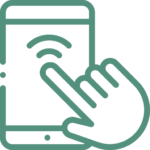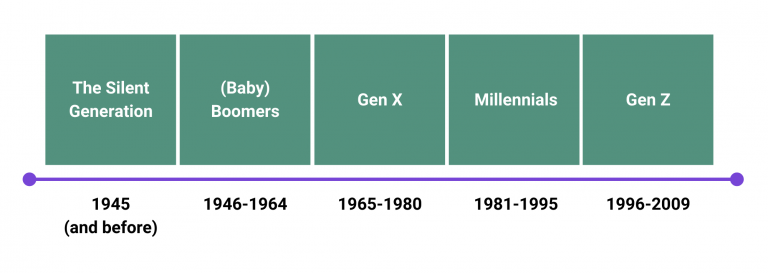As millennial donors start to take up a larger share of the world’s overall wealth, they are also taking up a larger share of overall philanthropic giving. Donor trends are changing to match millennial donor behavior. To optimize Millennial giving, you may need to rethink your fundraising strategy to reach this demographic.
By integrating Artificial Intelligence (AI) into your fundraising strategy, you can reach millennial donors. More specifically, AI can help you tailor your fundraising communications, so your campaigns resonate with millennials better. But before we explore how you can boost your millennial giving using AI-powered fundraising, let’s discuss who millennials donors are.
Who Are Millennial Donors?
Millennial Donors Are:

Tech-savvy
They are comfortable using digital platforms to give online.

Generous
When reaching out to millennial donors, be specific with your ask — or suggest a range.

Great Recurring Donors
They are familiar with subscriptions and are open to making donations that are spread over a long period.

Well-informed
Communicate your impact clearly with millennial donors using stories, data, testimonials, and other social proof.

Inquisitive
Keep an open door policy when engaging with donors. Be open to answering their questions and let them know their contributions make a difference.
Born between 1981 and 1996, millennials are the children of the boomer generation. They are the first generation to grow up with computers and mobile phones. As such, millennials are tech-savvy, and digital fundraising is essential to reach this demographic.
Millennials are also generous; they give more than previous generations, given how much they actually have or earn. Despite the widening wage gap and concentration of wealth, there is still space for small everyday donors among millennials.
Millennials also do not wait for typical milestones, like marriage (which they are reaching later) or parenting, before making donations. This means you can reach them earlier in their lives and secure even more recurring donations from this cohort over a long time—and with the advent of today’s subscription culture, millennials are very familiar and comfortable with the idea of recurring payments/contributions.
Millennials are the pioneers of social media, so they are incredibly connected. The world started to feel a whole lot smaller once you could connect with people anywhere, making millennial philanthropy more global and democratic than ever before.
With so much information available at the click of a button, millennials are also more informed about the issues they support than the generations before them.
They are also (dare I say) demanding. Millennials are not afraid to question the status quo and demand better of themselves, society, and the nonprofits they support. They are pushing the nonprofit sector to perform, well, better. Not a bad thing, if you ask me!
This article will help you reach these tech-savvy young donors, who are generous, well-informed, and well connected using Artificial Intelligence.
What Do Millennial Donors Want?
Millennials expect transparency, authentic relationships with nonprofits, and a personalized donor experience. Let’s explore how your millennial fundraising strategy can meet these expectations.

1. Millennial Donors Want Nonprofits To Be Transparent
Millennials value accountability. They are not afraid to call out something wrong and call in someone trying to do better. As an organization, you need to be accountable for your actions and transparent with your campaign practices and outcomes because they will notice if you have something to hide.
You can do this by publishing your annual expenditures, doing an internal audit of your operations to find improvement opportunities (then making the improvements), and publishing board meeting minutes.
Being transparent is a massive opportunity for nonprofit organizations, especially those without name recognition or long legacies. Millennials are just as likely to donate to nonprofits doing work they connect with as larger organizations with flashy ads on TV.
You can also be transparent and capture this opportunity by clearly communicating your organization’s impact. Storytelling is an excellent tool for helping donors connect with your cause, but backing this up with data provides the transparency and legitimacy that millennials are looking for and gives your narrative a strong foundation.
AI-powered tools like KIT can help you pull together detailed impact reports that millennials have come to expect. This saves you the work of computing this yourself, and you can use this impact analysis in your communications with donors.
2. Millennial Donors Want to Develop Authentic Relationships with Nonprofits
Millennial fundraising needs to be built on authenticity. Millennial donors are more connected to issues than institutions, which means that they will not donate to your organization based on name recognition alone.
They will search out organizations that they feel are doing the best work for the cause they are passionate about. This is great news for small grassroots organizations and means that nonprofits need to focus on helping donors feel connected to their mission.
Communicating your organization’s impact is a good place to start. But how do you help the donor feel connected to your organization? You do what fundraisers do best: nurture relationships.
Millennials value authenticity. As such, commonplace fundraising strategies, like gala dinners, can feel out of touch. Consider giving donors an opportunity to volunteer at your organization. Or perhaps create an online petition, or peer-to-peer campaign, that they can share with their friends. This direct engagement with your cause helps donors feel loyal to your organization.
Does this sound time-consuming? If you were doing all of this work yourself, for every donor, then it would be. But Artificial Intelligence can automate a lot of this work for you.
For example, you can add a chatbot to your website that prompts visitors with different questions based on the page they land on, or where they click and answer their questions for them. So when a donor clicks on one of your programs on your website, the chatbot may suggest they share a link to their petition for that campaign on their social media page.
Better yet, the chatbot may provide a direct link to the donation page. Millennials expect donating to be simple. If they can order dinner through an app without speaking to anyone, they expect to also be able to make a donation that way if they want to.
Artificial Intelligence can help you automate time-consuming tasks like crafting email campaigns, segmenting donors, or analyzing donor data. This frees up more time for fundraisers like yourself to think about more ways to nurture your donor relationships.
3. Millennial Donors Want to Receive a Personalized Donor Experience
Millennials are used to receiving personalized experiences. When they shop for jeans, other styles are suggested to them based on their browsing history. Their Instagram feed is curated based on their engagement and interests. So, when it comes to giving they expect the same tailored experience—it is the new norm.
You can create this for millennial donors by first getting to know your donors, then providing an individualized experience. Collecting donor data is a great way to get to know your donor base, and using artificial intelligence tools is the best way to analyze it.
Tools like KIT will analyze your donor database and show you trends and patterns in the data so you can understand your donors and adjust your fundraising strategy accordingly. You can use this information to create a personalized experience for each donor.
AI-powered tools, like KIT, can help you treat each donor differently without spending hours personalizing each interaction. KIT can segment your donor list so you can modify the way you engage with each segment. More so, this tool can score your donors so you can target those who are most likely to give to a campaign.
4 Ways to Improve Your Millennial Fundraising Strategy
As donor behavior changes with time, you can keep up by using AI-powered nonprofit tools to engage donors, automate tasks, understand your donor base and communicate your impact.
As more millennials accumulate wealth, they are more motivated to donate, so you need to capture their attention now. You can do this by being transparent, creating authentic donor connections, and a personalized donor experience.
That said, I will leave you with four next steps you can take to optimize your millennial fundraising strategy:
1. Audit Your Donor Database
Take some time to review your existing donor data. What percentage of your donor base are donors? Is your mission relevant to millennials? Are you doing a good job of attracting millennial donors? These questions will serve as a good starting point to work from.
2. Review Your Impact Report
Next, look over your impact reporting. How are you communicating your impact with donors? Could your report use an update? Take a look at Brightest if you need a hand with your impact report.
3. Optimize Your Donor Engagement Strategies
Look at your donor engagement. How are you creating avenues for donors to feel connected to your organization? Are you active on social media? Do you provide volunteer opportunities? If not, maybe it is time to look at KIT.
4. Refine Your Donor Segments
Are your segments working for you? Do you segment your donors manually? Maybe it’s time to try a donor management software like Keela.

Talk to a fundraising expert today to learn more about how Fundraising KIT can quickly and easily help your nonprofit raise more for your cause.
Your millennial fundraising strategy should resonate with millennials. So, consider bringing a millennial on board or consulting the millennial you already have on your team. Get their opinions on your proposed strategy, communication channels, and messaging and, actually, listen to them.

Ally Smith
Content Writer at Fundraising KIT
With a passion for nonprofit innovation, Ally has spent her career helping build community capacity and supporting social innovation as a customer success manager turned, youth worker, turned social researcher.
After leaving the tech start-up landscape, she pursued a Master’s in Philanthropy and Nonprofit Leadership and has since supported nonprofits to innovate and grow. A Canadian ex-pat and social entrepreneur based in Edinburgh, she enjoys hiking, baking bread in a panic, and pursuing the full Scottish experience- rain and rugby included!







